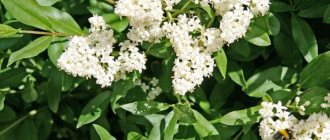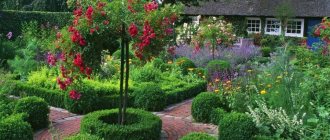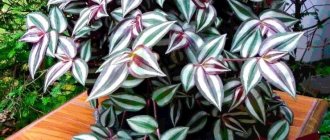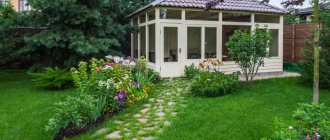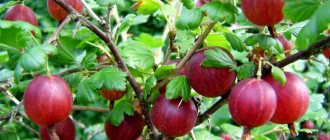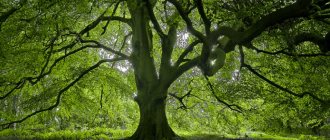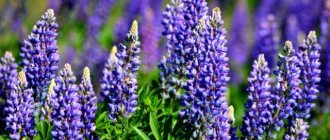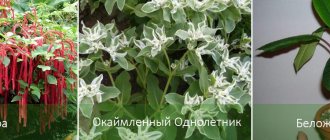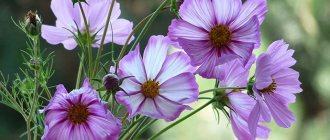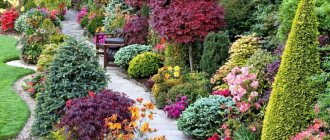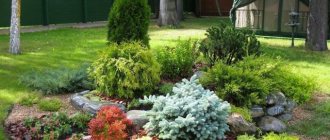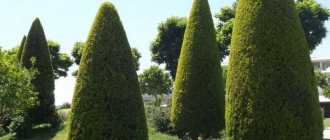The yew tree (Taxus) is a beautiful evergreen plant. It is also called Tiss in another way. It can be a dwarf shrub or a large thirty-meter tree. The shape of the crown, color, and size of the needles largely depend on the type of plant. Magnificent yew is widely used by landscape designers. It decorates the area and at the same time can serve as a protective fence due to its densely growing, tightly fitting branches.
Description of the genus
Representatives of the yew family differ in appearance, but all look amazingly beautiful. The yew plant grows slowly, but lives long. The age of a coniferous tree reaches more than five thousand years. The width of an adult tree in trunk diameter can reach four meters. All seasons the plant's soft, flat needles are green. Some species have narrower needles and different colors.
The brown bark of the tree, depending on the type and age, has a gray or red tint. During the period of active growth, the yew can change the shape of the crown from ovoid to cylindrical and vice versa. Giving a decorative shape by pruning makes the shape of the crown even denser and more beautiful. The tree prefers a shady location on the site.
What does pointed yew look like?
The pointed yew is a coniferous evergreen dioecious tree up to 12 m high. In our cedar-yew grove (Amur region) it is a shrub, and on the sea coast it is a dwarf tree. The yew trunk is irregular in shape, the bark is thin, reddish-brown, and in old trees it peels off in plates. The needles are flat, soft, pointed at the top. Hence the name - pointed yew.
Propagated by seeds. The yew seed is single, oval (approximately 6 mm in length and 4 mm in diameter), brown in color. Surrounded by a fleshy, ring-shaped, coral-red, goblet-shaped appendage. It blooms, or rather gathers dust, in May-June. Yew pollen does not have flight sacs and is therefore pollinated by the wind. The seeds ripen in August-September, but I have never seen many seeds on the bush. Are the birds pecking at something? Or does it bear fruit poorly?
Types and varieties
The genus Yew includes several varieties. They differ in crown shape, needle color, and growth rate. There are varieties that have wide, thick leaves instead of needles.
The most famous types of yew, their varieties:
- Canadian (Taxus canadensis). Height up to two meters. The branches are directed upward and grow at an angle, so the crown of the tree is wide. Slightly curved flat needles grow up to 25 mm. In winter, the green needles darken and become brown. The fruits of the Canadian yew resemble berries in appearance. They are poisonous to people and many animals. The tree is frost-resistant and has a shallow root system. The most common varieties are:
- "Broivnii." Dwarf yew (no more than 2.5 meters) with a rounded crown. Green needles are curved;
"Moon." The branches are pressed tightly against each other and grow upward;
- "Grandifolia". The crown shape is squat and straight. The green needles are larger than other varieties. Reach three centimeters.
- Pointed (taxus cuspidata). Tall (up to 20 meters) evergreen conifer. It can grow as a creeping shrub. The crown shape is asymmetrical. The branches grow horizontally to the ground or lean toward it. The seed of such a yew is oval, flattened, surrounded by a red fleshy aneurysm. Birds love these berries. They are not poisonous, like, for example, the needles of this species. The most popular varieties:
- "Capitata Aurea". The branches are directed upward, growing at an angle. Multi-stemmed bush with green needles with a yellow border;
"Dwarf Bright Gold" The bush grows up to one and a half meters. The crown is thick, dense, flattened. The needles are green with a yellow border.
- "Nana" A dwarf, slow-growing bush, with a crown resembling a small cloud. The needles are short, dark green.
- Yew berry (Taxus baccata). Can grow up to 30 meters. The thick fluffy crown has a cylindrical shape and several tops. It can grow in different conditions and adapt to different types of soil. Has a strong root system. The fruits of the tree ripen in autumn. Almost all parts of the plant are poisonous. Known varieties:
- "David" Mini-tree with a narrow columnar crown shape. Frost-resistant, loves partial shade;
Elegantissima. The cup-shaped crown of the dwarf bush grows by about 10-15 cm per year. The needles are green-white;
- "Summer Gold" The needles of the dwarf yew turn yellow after the growing season. The shape of the crown is spreading, wide and slightly flattened.
- Medium (Taxus media). It is sometimes called intermediate yew, as it occupies an intermediate position between berry and pointed yew. It tolerates winter well and can grow in shaded areas. Its varieties:
- Fairview. A dwarf bush with a spreading crown. After 10 years, it reaches only 30 cm in height, but grows well in width;
- Farmen. A small shrub with a dense crown. The shoots are tough with dark green needles;
- "Hicksii". Tall shrub (up to 3 meters). The branches are directed upwards. Fruits with red seeds.
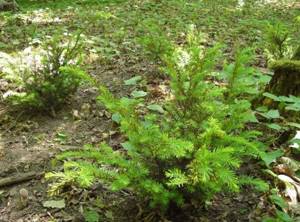
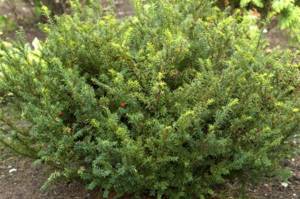
Places and conditions of growth
The pointed yew lives in cedar-deciduous and coniferous forests, and grows singly or in small groups. Slow growing and shade loving breed. In addition, it suffers from sudden lightening and dies in clearings. Subsequent regeneration of yew in such areas no longer occurs.
For normal development, yew needs good soil, and it does not tolerate soils with high acidity. In the Sikhote-Alin mountains, the pointed yew rises to a height of up to 900 m above sea level. Prefers places with deep snow cover, which protects it from severe frosts. In such conditions, it bears fruit poorly and reproduces mainly vegetatively. Yew is smoke, gas and wind resistant. In addition, he is a record long-liver: he lives up to 1000 years or more.
Planting and care
In order to grow Yew in a garden plot, you will need free space, since the roots of the system develop in the surface layers of the soil. For dwarf varieties you will need about a meter of free land, for ordinary trees and shrubs - about three meters. It is preferable to choose the time for planting from the beginning of April to the end of May, but it can also be planted in the fall. The pit for planting must be prepared in advance:
- dig a hole wider than an earthen ball with a root of 30 cm;
- put drainage on the bottom;
- Place humus and the remains of last year's needles inside.
The soil is prepared from several components. To do this you will need equal parts: sand, turf soil, peat. You need to pour a little of the prepared mixture into the hole, place the roots of the plant, and then sprinkle with the rest of the soil. The root collar should not be buried deep. After planting, the seedling needs to be watered with plenty of water, while irrigating the needles. It is important to plant the plant in the shade. Direct sunlight can be harmful to it.
Caring for yew is easy. Some dwarf varieties of trees or shrubs can be grown in flowerpots and pots in spacious rooms. With the arrival of spring, you need to trim off dead old branches. After this, it is recommended to spray against pests and diseases.
The first year after planting on the site, yew needs regular watering. Severely dry or overly wet soil can harm the plant. Before watering, the soil should be checked. It should not be wet at a depth of 10 cm. On hot days in the evening the Yew tree is watered with irrigation.
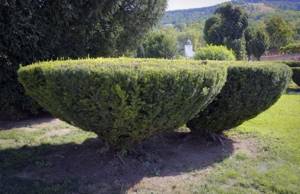
To make the crown shape decorative, yew can be cut only when it reaches the age of 10 years. Otherwise, it may interfere with basic growth. Fertilizer feeding is carried out annually. These are ordinary mineral mixtures for conifers. You need to add compost in a timely manner and water it with a humus solution.
Planting yew in open ground
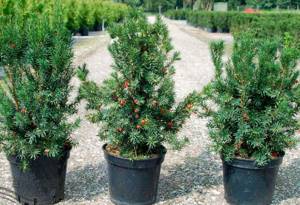
What time to plant
Yew is planted in open ground from the last days of August to October. In areas with a mild climate, such a plant is planted in October, in the area that, in the gardener’s opinion, is most suitable for this. If in the region where the yew will be grown, the summer period is relatively short, then it is recommended to plant it in the last summer or first autumn weeks, and for this you should definitely choose well-lit areas. If the seedling has a closed root system, then it can be planted throughout the entire growing season, but this procedure must be completed before October in areas with mild winters, and no later than the first half of September in regions with a colder climate and short summers.
We must try to protect such a plant from drafts at least during the first few years after planting the seedling in open soil. It is recommended to grow yew in well-drained, light and fertile soil; its composition can be approximately the following: sand, peat and leaf or turf soil (2: 2: 3). But it should be noted that it grows quite well in poor soil. This crop is completely unsuitable for overly moist or overly acidic soil.
Landing rules

To plant a seedling, you need to prepare a hole, the depth of which should be at least 0.7 m, and its width should be 0.2 m greater than the volume of the root system of the seedling taken with a lump of earth. To create a hedge, it is recommended to plant seedlings in a trench, the depth of which should be about 0.5–0.7 m. A distance of 150–200 cm should be maintained between bushes, while when planting a hedge it should be less - approximately 50 cm. When the pit is ready, it is necessary to make a good drainage layer at its bottom, the thickness of which should be approximately 0.2 m. Broken brick, crushed stone, river sand or pebbles can act as drainage material.
The seedling in the container must be watered very well, after which it is carefully pulled out of the container and placed in the planting hole. The free space in the pit must be filled with a pre-prepared soil mixture (see composition above), to which complex mineral fertilizer must be added. For example, you can use Nitroammofoska (1 gram per 1 liter of soil), Kemira-universal (100 grams per 1 m2 of soil mixture) or copper sulfate (15 grams per 1 liter of soil). After planting is completed, the root collar of the plant should be flush with the surface of the site. When the yew is planted, the soil around the bush must be compacted well. Water it well, and after the liquid is completely absorbed into the soil, the surface of the tree trunk circle should be covered with a layer of mulch (peat or compost).
Yew berry. We plant correctly and for a long time.
Reproduction
The simplest known method of propagating a yew tree is cuttings. You can choose shoots that already have their own decorative features. Cuttings not only of the first year of life, but also older ones are suitable for this. The shape can be created as the plant grows. Young branches can be directed upward, pressing them against the main trunk, or placed horizontally on the ground, forming the desired crown.
To root the cuttings, in the fall they take the tops of the shoots with the woody part and clear them of needles. Then the shoots are treated with a root formation stimulator, deepened into a mixture of peat and perlite, and watered. The temperature of the mixture should be no more than 10 degrees Celsius. In the spring, young cuttings are transplanted into containers, and in the fall to a prepared area.
Propagation by seeds will require more care and time. They germinate unevenly, and the variety that the gardener expects does not always grow. But still, this method of reproduction exists.
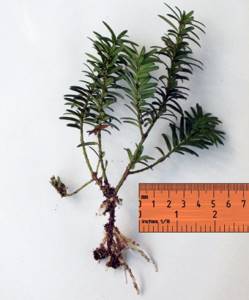
To do this, you need to collect the seeds and fruits of plants in the fall, peel them from the pulp and spend three months at a temperature of approximately 20 °C. Then they are moved to a container with damp moss and placed in the cold for two months, approximately 3-5 °C. In spring, seeds are sown in boxes with prepared moist soil and covered with film.
Diseases and pests
A yew tree or shrub can get sick with: brown schutte, fomoz, necrosis, fusarium. It is not difficult to understand that a plant is sick. Usually, the first signs are a change in the color of the needles or their loss. This can occur when fungal infections affect damaged parts of the bark. For prevention, the plant should be sprayed with fungicidal agents containing copper.
Pests of Yew are pine-eating insects. The first signs of damage are yellowing of the needles, their death, and death of branches. To destroy pests, you need to remove the affected branches and spray the plant with special insecticides two or three times every 10-12 days.
Taking into account the climate
Many types of yew easily adapt to different climate conditions. But you can grow a tree or bush in the Moscow region only by choosing the right variety for planting. For example, it is better not to plant yew berry in a climate that is colder than temperate continental. It grows well in the Caucasus, Sochi and Crimea, and Kaliningrad.
The pointed yew is suitable for growing in the latitudes of Japan, China, and the Russian Far East. In northern latitudes, it is better to choose frost-resistant Canadian yew for planting, but it is difficult to find its seedlings in cultivation even in nurseries. The average yew is also quite resistant to frost. It is quite possible to grow it in the climate near Moscow, observing certain planting rules and, if necessary, providing reliable protection for the winter.
Meaning and Application
The yew is an evergreen plant that is harmless to wild animals, but is considered poisonous to humans and livestock. Small doses of poison are used as medicine. Yew wood has antibacterial properties, as it contains phytoncides. It is used to make house ceilings or furniture, which serve as protection against infections.
Where was yew used before it was included in the Red Book?
The wood of yew is fine-grained, with narrow light yellow sapwood and a red-brown heartwood. For this, the pointed yew is popularly nicknamed “mahogany”. Dense, hard and elastic, but relatively fragile wood, difficult to split. It does not contain resin (like bark), is almost not subject to rotting (“non-rot-wood”) and is highly polished. In air it darkens, acquiring the color of “ebony”.
If you keep the wood in ordinary water, it turns purple-crimson. If soaked in lime water it turns purple-red. Suitable for furniture parts and finishing; for turning, carving, carpentry and souvenir products; musical instruments (flutes, clarinets, violins, etc.). In the form of sliced veneer, it is used for finishing furniture, radios, televisions and other products.
